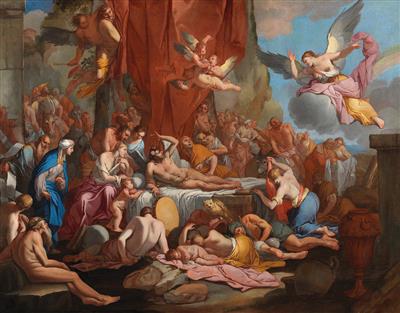Giulio Carpioni

(Venice 1613–1678)
Iris Arriving in Hypnos’s Empire
oil on canvas, 108 x 137 cm, framed
Provenance:
sale, Dorotheum, Vienna, 12 March 1998, lot 146;
sale, Christie’s, London, 5 July 2007, lot 44
Literature:
A. Ballarin, Carpioni, by Giuseppe Maria Pilo, in: The Burlington Magazin, CV, 726, September 1963, p. 412, fig. 34
The present painting, an important work from the artist’s mature period, refers to a theme from Ovid’s Metamorphoses (XI: 585–632). It relates to the story of Hypnos, the Greek god of sleep, whose empire is described as a cave in the mountains where the river Lethe, personified here as the river god in the left foreground, has its source. The winged figure of Hypnos, crowned with opium poppy and with the owl as his attribute, wakes up as Iris arrives, descending from a rainbow and delivering a message from Juno. His entourage, consisting of Morpheus, his son ( also represented here as a winged figure) and other dream deities, sleepily moves back at the sight of Iris’ splendour.
Carpioni repeatedly revisited the present subject, which rarely occurs in traditional iconography. Similar versions are at the Kunsthistorisches Museum, Vienna and at the Szépmüvészeti Múzeum, Budapest (see G. M. Pilo, Giulio Carpioni, Venice, 1961, p. 126, fig. 50 and p. 89, fig. 61). Giuseppe Maria Pilo dates the present composition to the mid-1660s (written communication, 1998). In its bright tonality and brilliant colours, the painting resembles works from the artist’s maturity, such as the painting in the Schönborn Collection, Pommersfelden, or a painting in a private collection in Venice (see G. M. Pilo, 1961, p. 117, fig. 112 and p. 107, fig. 88).
Mythological themes like the present scene and bacchanals number among Carpioni’s most original and unmistakable works. They reveal the artist’s closeness to the art of Poussin, whose oeuvre Carpioni admired and was familiar with from Pietro Testa’s etchings. The stage-like character of the composition, on the other hand, recalls Titian and Venetian painting. Such cabinet pieces were not only intended to please the eye, but also to encourage intellectual discussion. The high quality and accomplished balance of the composition show that Carpioni, having arrived at the zenith of his career, absorbed various influences and combined them with his own highly individual pictorial elements.
20.10.2015 - 18:00
- Odhadní cena:
-
EUR 80.000,- do EUR 120.000,-
Giulio Carpioni
(Venice 1613–1678)
Iris Arriving in Hypnos’s Empire
oil on canvas, 108 x 137 cm, framed
Provenance:
sale, Dorotheum, Vienna, 12 March 1998, lot 146;
sale, Christie’s, London, 5 July 2007, lot 44
Literature:
A. Ballarin, Carpioni, by Giuseppe Maria Pilo, in: The Burlington Magazin, CV, 726, September 1963, p. 412, fig. 34
The present painting, an important work from the artist’s mature period, refers to a theme from Ovid’s Metamorphoses (XI: 585–632). It relates to the story of Hypnos, the Greek god of sleep, whose empire is described as a cave in the mountains where the river Lethe, personified here as the river god in the left foreground, has its source. The winged figure of Hypnos, crowned with opium poppy and with the owl as his attribute, wakes up as Iris arrives, descending from a rainbow and delivering a message from Juno. His entourage, consisting of Morpheus, his son ( also represented here as a winged figure) and other dream deities, sleepily moves back at the sight of Iris’ splendour.
Carpioni repeatedly revisited the present subject, which rarely occurs in traditional iconography. Similar versions are at the Kunsthistorisches Museum, Vienna and at the Szépmüvészeti Múzeum, Budapest (see G. M. Pilo, Giulio Carpioni, Venice, 1961, p. 126, fig. 50 and p. 89, fig. 61). Giuseppe Maria Pilo dates the present composition to the mid-1660s (written communication, 1998). In its bright tonality and brilliant colours, the painting resembles works from the artist’s maturity, such as the painting in the Schönborn Collection, Pommersfelden, or a painting in a private collection in Venice (see G. M. Pilo, 1961, p. 117, fig. 112 and p. 107, fig. 88).
Mythological themes like the present scene and bacchanals number among Carpioni’s most original and unmistakable works. They reveal the artist’s closeness to the art of Poussin, whose oeuvre Carpioni admired and was familiar with from Pietro Testa’s etchings. The stage-like character of the composition, on the other hand, recalls Titian and Venetian painting. Such cabinet pieces were not only intended to please the eye, but also to encourage intellectual discussion. The high quality and accomplished balance of the composition show that Carpioni, having arrived at the zenith of his career, absorbed various influences and combined them with his own highly individual pictorial elements.
|
Horká linka kupujících
Po-Pá: 10.00 - 17.00
old.masters@dorotheum.at +43 1 515 60 403 |
| Aukce: | Obrazy starých mistrů |
| Typ aukce: | Salónní aukce |
| Datum: | 20.10.2015 - 18:00 |
| Místo konání aukce: | Wien | Palais Dorotheum |
| Prohlídka: | 10.10. - 20.10.2015 |
Všechny objekty umělce
